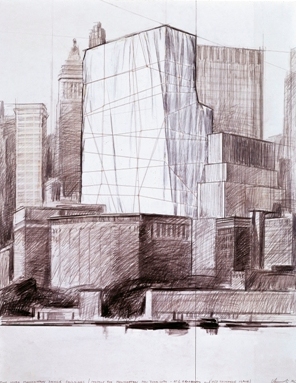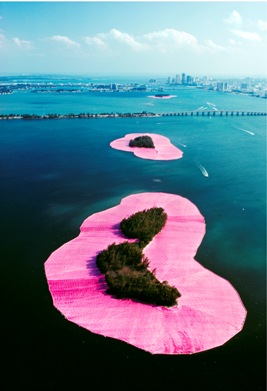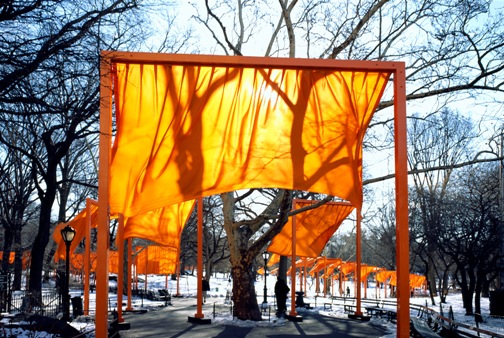Christo and Jeanne-Claude, 40 Years, 12 Exhibitions, Annely Juda Fine Art | reviews, news & interviews
Christo and Jeanne-Claude, 40 Years, 12 Exhibitions, Annely Juda Fine Art
Christo and Jeanne-Claude, 40 Years, 12 Exhibitions, Annely Juda Fine Art
Two artists, 40 years, 12 exhibitions, 1 gallery: a story of partnerships

A retrospective of an artist’s work is not usually a history of a working relationship, but in the case of Christo, this impressive exhibition of works from the past 40 years also marks two crucial partnerships: with his wife, Jeanne-Claude, who was his equal and co-creator from 1961, and with the Annely Juda gallery, which has mounted 12 exhibitions over four decades, as well as being intimately involved in their massive environmental “wrapped” pieces.
 The very nature of the projects Christo and Jeanne-Claude planned means that a quarter-century might pass between initial conception and reality. Thus early plans for the wrapping of the Reichstag (main image) are dated 1972, and are collages of fabric, twine, drawn-on photographs and tiny pre- and post-war snapshots (of the burning of the building in 1933 and its bombed skeleton in 1945); these are followed by 1990s photographs and drawings, and then the final spectacular photographs in 1995.
The very nature of the projects Christo and Jeanne-Claude planned means that a quarter-century might pass between initial conception and reality. Thus early plans for the wrapping of the Reichstag (main image) are dated 1972, and are collages of fabric, twine, drawn-on photographs and tiny pre- and post-war snapshots (of the burning of the building in 1933 and its bombed skeleton in 1945); these are followed by 1990s photographs and drawings, and then the final spectacular photographs in 1995.
Other projects the pair contemplated were never realized. (For example, Two Lower Manhattan Packed Buildings, pictured above) (Christo was named as the sole artist until 1994, when Jeanne-Claude’s contribution was formally acknowledged, both on new work and retroactively.) The fabulous tiny photo-montage Packed Building, Project for 1 Times Square has all the reality it ever had in the gallery of Annely Juda: the model, a photograph of which was inserted into a photograph of Times Square in those pre-Photoshop days: the combination of methods gives a kind of “pop” to the image, making it three-dimensional and slightly triffid-like in a way that computer-manipulation never would – by making it more real-looking, computers take away the artistry.
Before the wrapping, however, came plans for re-created storefronts, and the plan have a rougher, more improvised feel with their wood bases, and roughly outlined dimensions. They stand beside Show Window and Purple Store Front from the mid-1960s, both of which turn our ideas of Christo inside-out. This is not the wrap-er we know, not someone who covers up already created objects, who carves lines through the natural world, but someone who makes us look again at the mundane by recreating it in a gallery space. The window and the store-front are creepy, not because they are unusual, but because they are in the wrong place cognitively.
 The early wrapped objects – here some tin cans, a table and chair with a candelabra, and a series of mysterious bundles – also acquire their aura through relocation: cans don’t belong in galleries, the seemingly elegant table, candelabra and chair are covered by ugly plastic. Part of this is the ageing process. Like Eva Hesse’s work, some of Christo’s earlier pieces have acquired an extra layer of meaning by the degeneration of the materials he worked with. The plastic on the chairs is yellowed, dusty and aged, none of which would have been the case in 1963.
The early wrapped objects – here some tin cans, a table and chair with a candelabra, and a series of mysterious bundles – also acquire their aura through relocation: cans don’t belong in galleries, the seemingly elegant table, candelabra and chair are covered by ugly plastic. Part of this is the ageing process. Like Eva Hesse’s work, some of Christo’s earlier pieces have acquired an extra layer of meaning by the degeneration of the materials he worked with. The plastic on the chairs is yellowed, dusty and aged, none of which would have been the case in 1963.
Ageing, too, has changed our view of the earliest project Jeanne-Claude and Christo worked on together, the wall of oil-barrels blocking a street in Paris. Here the photomontaged image makes this look like one of their later, non-political installations, but the date, 1961, is also the date the Berlin Wall was erected. And upstairs in the gallery, their latest plan, for a vast pyramid of oil-drums in Abu Dhabi, likewise cannot be seen apolitically. Here even the model looms, showing how the plans have grown in size from that small wall in Paris.
But so much of the show is just sheer aesthetic enjoyment. (Collage for Surrounded Islands, Project for Biscayne Bay, 1983, pictured above left) The drawing for a wrapped wall in Rome makes us look at shape and void differently, as all good sculpture does. What is, unwrapped, a historical curiosity (an ancient wall bisected by traffic lanes) becomes a study in volume. A drawing for the Valley Curtain project in Colorado reveals and conceals, making us think about how we view landscape, but it is also simply a glorious orange flaming flag.
 For the greatest joy of a Christo/Jeanne-Claude installation is the sheer sensual delight it brings. This can be seen in the photographs – the crowd around the wrapped Reichstag is not standing silently in awe, but participating. The Gates, in Central Park (above), made this even clearer. As the fabric flapped snappily over the park’s paths, rivers of art-lovers streamed underneath, each person creating their own parade.
For the greatest joy of a Christo/Jeanne-Claude installation is the sheer sensual delight it brings. This can be seen in the photographs – the crowd around the wrapped Reichstag is not standing silently in awe, but participating. The Gates, in Central Park (above), made this even clearer. As the fabric flapped snappily over the park’s paths, rivers of art-lovers streamed underneath, each person creating their own parade.
The expense and logistics involved ensure that Christo/Jeanne-Claude installations occur only rarely. But this joyous collaboration between artists and gallery permit viewers, at least vicariously, to understand what these master-wrappers are all about.
- Christo and Jeanne-Claude, 40 Years, 12 Exhibitions at Annely Juda Fine Art until 22 October
rating
Share this article
The future of Arts Journalism
You can stop theartsdesk.com closing!
We urgently need financing to survive. Our fundraising drive has thus far raised £49,000 but we need to reach £100,000 or we will be forced to close. Please contribute here: https://gofund.me/c3f6033d
And if you can forward this information to anyone who might assist, we’d be grateful.

Subscribe to theartsdesk.com
Thank you for continuing to read our work on theartsdesk.com. For unlimited access to every article in its entirety, including our archive of more than 15,000 pieces, we're asking for £5 per month or £40 per year. We feel it's a very good deal, and hope you do too.
To take a subscription now simply click here.
And if you're looking for that extra gift for a friend or family member, why not treat them to a theartsdesk.com gift subscription?
more Visual arts
 'We are bowled over!' Thank you for your messages of love and support
Much-appreciated words of commendation from readers and the cultural community
'We are bowled over!' Thank you for your messages of love and support
Much-appreciated words of commendation from readers and the cultural community
 Folkestone Triennial 2025 - landscape, seascape, art lovers' escape
Locally rooted festival brings home many but not all global concerns
Folkestone Triennial 2025 - landscape, seascape, art lovers' escape
Locally rooted festival brings home many but not all global concerns
 Sir Brian Clarke (1953-2025) - a personal tribute
Remembering an artist with a gift for the transcendent
Sir Brian Clarke (1953-2025) - a personal tribute
Remembering an artist with a gift for the transcendent
 Emily Kam Kngwarray, Tate Modern review - glimpses of another world
Pictures that are an affirmation of belonging
Emily Kam Kngwarray, Tate Modern review - glimpses of another world
Pictures that are an affirmation of belonging
 Kiefer / Van Gogh, Royal Academy review - a pairing of opposites
Small scale intensity meets large scale melodrama
Kiefer / Van Gogh, Royal Academy review - a pairing of opposites
Small scale intensity meets large scale melodrama
 Jenny Saville: The Anatomy of Painting, National Portrait Gallery review - a protégé losing her way
A brilliant painter in search of a worthwhile subject
Jenny Saville: The Anatomy of Painting, National Portrait Gallery review - a protégé losing her way
A brilliant painter in search of a worthwhile subject
 Abstract Erotic, Courtauld Gallery review - sculpture that is sensuous, funny and subversive
Testing the boundaries of good taste, and winning
Abstract Erotic, Courtauld Gallery review - sculpture that is sensuous, funny and subversive
Testing the boundaries of good taste, and winning
 Edward Burra, Tate Britain review - watercolour made mainstream
Social satire with a nasty bite
Edward Burra, Tate Britain review - watercolour made mainstream
Social satire with a nasty bite
 Ithell Colquhoun, Tate Britain review - revelations of a weird and wonderful world
Emanations from the unconscious
Ithell Colquhoun, Tate Britain review - revelations of a weird and wonderful world
Emanations from the unconscious
 Rachel Jones: Gated Canyons, Dulwich Picture Gallery review - teeth with a real bite
Mouths have never looked so good
Rachel Jones: Gated Canyons, Dulwich Picture Gallery review - teeth with a real bite
Mouths have never looked so good
 Yoshitomo Nara, Hayward Gallery review - sickeningly cute kids
How to make millions out of kitsch
Yoshitomo Nara, Hayward Gallery review - sickeningly cute kids
How to make millions out of kitsch
 Hamad Butt: Apprehensions, Whitechapel Gallery review - cool, calm and potentially lethal
The YBA who didn’t have time to become a household name
Hamad Butt: Apprehensions, Whitechapel Gallery review - cool, calm and potentially lethal
The YBA who didn’t have time to become a household name

Add comment